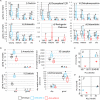Flavonoid Versus Artemisinin Anti-malarial Activity in Artemisia annua Whole-Leaf Extracts
- PMID: 31417596
- PMCID: PMC6683762
- DOI: 10.3389/fpls.2019.00984
Flavonoid Versus Artemisinin Anti-malarial Activity in Artemisia annua Whole-Leaf Extracts
Abstract
Artemisinin, a sesquiterpene lactone produced by Artemisia annua glandular secretory trichomes, is the active ingredient in the most effective treatment for uncomplicated malaria caused by Plasmodium falciparum parasites. Other metabolites in A. annua or related species, particularly flavonoids, have been proposed to either act as antimalarials on their own or act synergistically with artemisinin to enhance antimalarial activity. We identified a mutation that disrupts the CHALCONE ISOMERASE 1 (CHI1) enzyme that is responsible for the second committed step of flavonoid biosynthesis. Detailed metabolite profiling revealed that chi1-1 lacks all major flavonoids but produces wild-type artemisinin levels, making this mutant a useful tool to test the antiplasmodial effects of flavonoids. We used whole-leaf extracts from chi1-1 and mutant lines impaired in artemisinin production in bioactivity in vitro assays against intraerythrocytic P. falciparum Dd2. We found that chi1-1 extracts did not differ from wild-type extracts in antiplasmodial efficacy nor initial rate of cytocidal action. Furthermore, extracts from the A. annua cyp71av1-1 mutant and RNAi lines impaired in amorpha-4,11-diene synthase gene expression, which are both severely compromised in artemisinin biosynthesis but unaffected in flavonoid metabolism, showed very low or no antiplasmodial activity. These results demonstrate that in vitro bioactivity against P. falciparum of flavonoids is negligible when compared to that of artemisinin.
Keywords: Artemisia annua; Plasmodium falciparum; artemisinin; chalcone isomerase; flavonoids; malaria.
Figures



References
-
- Bhakuni R. S., Jain D. C., Sharma R. P., Kumar S. (2001). Secondary metabolites of Artemisia annua and their biological activity. Curr. Sci. 80 35–48.
LinkOut - more resources
Full Text Sources

